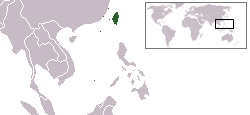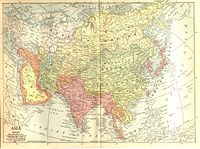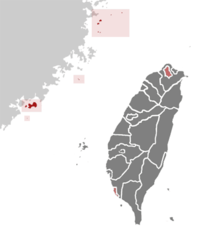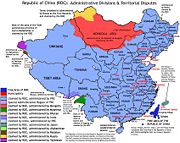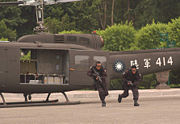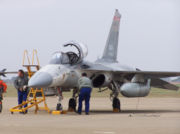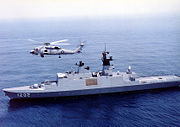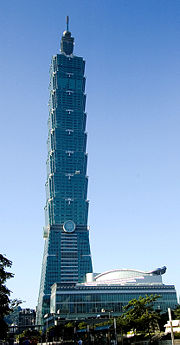Republic of China
2008/9 Schools Wikipedia Selection. Related subjects: Asia; Asian Countries
| 中華民國 Jhonghuá Mínguó Republic of China
|
||||||
|---|---|---|---|---|---|---|
|
||||||
| Anthem: National Anthem of the Republic of China |
||||||
|
|
||||||
| Capital (and largest city) |
Taipei |
|||||
| Official languages | Standard Mandarin (Guóyǔ) (Chinese) | |||||
| Demonym | Taiwanese or Chinese* | |||||
| Government | Semi-presidential system | |||||
| - | President | Ma Ying-jeou | ||||
| - | Vice President | Vincent Siew | ||||
| - | Premier | Liu Chao-shiuan | ||||
| Establishment | Xinhai Revolution | |||||
| - | Start of Xinhai Revolution | October 10, 1911 | ||||
| - | Republic established | January 1, 1912 | ||||
| - | Relocated to Taiwan | December 7, 1949 | ||||
| Area | ||||||
| - | Total | 36,188 km² ( 136th) 13,975 sq mi |
||||
| - | Water (%) | 10.34 | ||||
| Population | ||||||
| - | 2007 estimate | 22,911,292 ( 47th) | ||||
| - | Density | 633.12/km² ( 14th) 1,639.43/sq mi |
||||
| GDP ( PPP) | 2007 estimate | |||||
| - | Total | $695.388 billion ( 19th) | ||||
| - | Per capita | $30,126 ( 28th) | ||||
| GDP (nominal) | 2007 estimate | |||||
| - | Total | $383,307 billion ( 24th) | ||||
| - | Per capita | $16,274 ( 36th) | ||||
| HDI (2005) | ▲ 0.932 (high) ( 23rd if ranked) | |||||
| Currency | New Taiwan dollar (NT$) ( TWD) |
|||||
| Time zone | CST ( UTC +8) | |||||
| Internet TLD | .tw | |||||
| Calling code | +886 | |||||
| * Due to the government's territory after 1949 having little overlap with its pre-1945 territory, those who were nationals before 1949 are likely to be identified as "Chinese". Also, due to the controversial political status of Taiwan, those supporting Chinese reunification may refer to themselves as "Chinese" in addition or in place of "Taiwanese." Those favoring Taiwan independence tend to refer to themselves as "Taiwanese" only. | ||||||
| This article contains Chinese text. Without proper rendering support, you may see question marks, boxes, or other symbols instead of Chinese characters. |
The Republic of China ( Abbr: ROC; traditional Chinese: 中 華 民 國; simplified Chinese: 中 华 民 国; Hanyu Pinyin: Zhōnghuá Mínguó; Tongyong Pinyin: Jhonghuá Mínguó; Wade-Giles: Chung-hua Min-kuo; POJ: Tiong-hoa Bin-kok) is a state in East Asia that has evolved from a single-party state with full global recognition into a multi-party democratic state with limited international recognition. It was a founding member of the United Nations. Established in 1912, the Republic of China encompassed much of mainland China. In 1945 at the end of World War II the Republic of China added the island groups of Taiwan (Formosa) and the Pescadores to its authority. These island groups, together with Kinmen and Matsu, became the full extent of the Republic of China's authority after 1949 when the Kuomintang (KMT) lost the Chinese Civil War to the Chinese Communist Party and the People's Republic of China (PRC) was founded in mainland China. Under ROC law, these areas are known as the Free Area of the Republic of China.
Although the Republic of China has governed only Taiwan and outlying islands since 1949, during the early Cold War the ROC was recognized by most Western nations and the United Nations as the sole legitimate government of China. During the 1970s, the ROC began to lose these recognitions in favour of the People's Republic of China. The Republic of China has not formally relinquished its claim as the legitimate government of all China. Both Presidents Lee Teng-hui and Chen Shui-bian have held the view that it is a sovereign and independent country separate from mainland China and there is no need for a formal declaration of independence.
During the 1950s and 1960s, it was common to refer to the Republic of China as Nationalist China or Free China. Over subsequent decades, the Republic of China has been commonly referred to as "Taiwan". Since the late 1970s the name "China" is commonly used to refer to the People's Republic of China. Because of diplomatic pressure from the People's Republic of China, the Republic of China is referred to as " Chinese Taipei" in most international organizations. The capital city is Taipei.
The Republic of China was established in 1912, replacing the Qing Dynasty and ending over two thousand years of imperial rule in China. It is the oldest surviving republic in East Asia. The Republic of China on mainland China went through periods of warlordism, Japanese invasion, civil war between the Kuomintang and the Communists. The Republic of China on Taiwan has experienced rapid economic growth and industrialization, and democratization.
Starting in 1928, the Republic of China was ruled by the Kuomintang as an authoritarian one-party state. In the 1950s and 1960s, the KMT went through wide restructuring and decreased corruption and implemented land reform. There followed a period of great economic growth, the Republic of China became one of the Four Asian Tigers, despite the constant threat of war and civil unrest. In the 1980s and 1990s the government peacefully transitioned to a democratic system, with the first direct presidential election in 1996 and the 2000 election of Chen Shui-bian, the first non-KMT after 1949 to become President of the Republic of China. The KMT regained presidency and increased its majority in the legislature in the 2008 presidential and legislative elections.
Political status
The political status of the Republic of China is a contentious issue. The People's Republic of China claims that the ROC government is illegitimate, referring to it as the "Taiwan Authority", while the ROC views itself as an independent sovereign state. The ROC actively claimed to be the sole legitimate government of all China since its retreat to Taiwan in 1949 until the lift of martial law in 1987. Although the administration of pro-independence President Chen Shui-bian does not actively claim jurisdiction over all of China, the national boundaries of the ROC have not been redrawn and its outstanding territorial claims from the late 1940s have not been revised. Thus, the claimed area of the ROC continue to include Mainland China, several off-shore islands, Taiwan, Outer Mongolia, northern Burma, and Tuva (now Russian territory).
The political environment is complicated by the potential for military conflict should overt actions toward independence or reunification be taken. It is the policy of the People's Republic of China to use force to ensure reunification if peaceful reunification is no longer possible, as stated in its anti-secession law, and there are substantial military installations on the Fujian coast for this reason. As a result of Cold War politics, the United States has provided military training and sold arms to the ROC armed forces. However, the current status quo, as defined by the U.S., is supported on a quid pro quo basis between both Chinese states. The PRC is expected to "use no force or threat[en] to use force against Taiwan" and the ROC is to "exercise prudence in managing all aspects of Cross-Strait relations." Both are to refrain from performing actions or espousing statements "that would unilaterally alter Taiwan's status."
Within the ROC, opinions are polarized between those supporting unification, represented by the Pan-Blue Coalition of parties, and those supporting independence, represented by the Pan-Green Coalition of parties. The Kuomintang, the largest Pan-Blue party, supports the status quo for the indefinite future with a stated ultimate goal of unification. However, it does not support unification in the short term with the PRC as such a prospect would be unacceptable to most of its members and the public. Ma Ying-jeou, former chairman of the KMT and the current ROC President, has set out democracy, economic development to a level near that of the ROC, and equitable wealth distribution as the conditions that the mainland must fulfill for reunification to occur. The DPP, the largest Pan-Green party, also supports the status quo because the risk of provoking the PRC is unacceptable to its members. However, President Chen Shui-bian of the DPP has stated that no matter what, any decision should be decided through a public referendum of the people of the ROC. Both parties' current foreign policy positions support actively advocating ROC participation in international organizations, but the KMT accepts the " One-China" principle and the DPP encourages economic ties with countries other than the PRC for security reasons.
For its part, the People's Republic of China appears to find the retention of the name "Republic of China" far more acceptable than the declaration of a de jure independent Taiwan. However, with the rise of the Taiwanese independence movement, the name "Taiwan" has been employed increasingly more often on the island itself. The PRC has stated that any effort in Taiwan to formally abolish the ROC and replace it with a Republic of Taiwan would result in a strong and possibly military reaction. The current position of the United States is that the Taiwan issue must be resolved peacefully and unilateral action by either side is condemned; neither an unprovoked invasion by the PRC or a formal declaration of independence by Taiwan would be acceptable.
Citing its One-China policy, the PRC requires other countries to give no official recognition to the ROC as a condition of maintaining diplomatic relations. As a result, there are only 23 countries that have official diplomatic relations with the Republic of China. However, most countries have unofficial representative offices in the ROC. The United States maintains unofficial relations with the ROC through the instrumentality of the American Institute in Taiwan. The ROC maintains similar de facto embassies and consulates in most countries, called " Taipei Economic and Cultural Representative Offices" (TECRO), with branch offices called "Taipei Economic and Cultural Offices" (TECO). Both TECRO and TECO are "unofficial commercial entities" of the ROC in charge of maintaining diplomatic relations, providing consular services (i.e. Visa applications), and serving the national interests of the ROC in other countries in basically the same way as an embassy or consulate.
Also due to its One-China policy, the PRC only participates in international organizations where the ROC is not recognized as a sovereign country. In 1945, the ROC, as representative of all the territory of China, was one of the founding nations and Security Council member of the United Nations; however, in 1971, with the passage of United Nations General Assembly Resolution 2758, it was replaced by the PRC. Each year since 1992, the ROC has petitioned the UN for entry but has been unsuccessful. Most member states, including the United States, do not wish to discuss the issue of the ROC's political status for fear of souring diplomatic ties with the PRC. However, both the U.S. and Japan publicly support the ROC's bid for membership in the World Health Organization as an observer. However, though the ROC has applied for WHO membership every year since 1997 under various denominations, their efforts have consistently been blocked by PRC. Also, the Republic of China is pressured to use the politically neutral name "Chinese Taipei" in international events such as the Olympic Games when the PRC is also a party. The ROC is typically barred from using its national anthem and national flag in international events due to PRC pressure; ROC spectators attending events such as the Olympics are often barred from bringing ROC flags into venues. The ROC is able to participate as "China" in organizations that the PRC does not participate in, such as the World Organization of the Scout Movement.
The relationship with the PRC and the related issues of Taiwan independence and Chinese reunification continue to dominate ROC politics. For any particular resolution public favour shifts greatly with small changes in wording, illustrating the complexity of public opinion on the topic.
History
1911–27
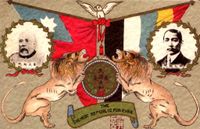
In 1911, after over two thousand years of imperial rule, China overthrew its dynastic system in favour of a republic. The Qing government, having just experienced a century of instability, suffered from both internal rebellion and foreign imperialism. The Neo-Confucian principles that had, to that time, sustained the dynastic system were now called into question and a loss of cultural self-confidence was blamed for a total of 40 million Chinese consumers of opium by 1900 (roughly 10% of the population). By the time of its embarrassing defeat by an expeditionary force led by the world's major powers in 1900 during the suppression of the Boxer Rebellion, the Qing government was already in its final throes, with only the lack of an alternative regime in sight prolonging its existence until 1912.
The establishment of Republican China developed out of the Wuchang Uprising against the Qing on October 10, 1911. The Republic of China was established on January 1, 1912, with Dr. Sun Yat-sen as the provisional president. As part of the agreement to have the last emperor Puyi abdicate, Yuan Shikai was officially elected president in 1913. However, Yuan dissolved the ruling Kuomintang party (KMT), ignored the provisional Constitution by asserting presidential power, and ultimately declared himself Emperor of China in 1915.
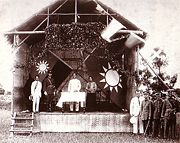
Yuan's supporters deserted him, and many provinces declared independence and became warlord states. Yuan Shikai died of natural causes in 1916. This thrust China into a decade of warlordism. Sun Yat-sen, forced into exile, returned to Guangdong province with the help of southern warlords in 1917 and 1920, and set up successive rival governments. Sun re-established the KMT in October, 1919.
The central power in Beijing struggled to hold on to power. An open and wide-ranging debate evolved regarding how China should confront the West. After the Treaty of Versailles, on May 4, a student protest led to a nationwide uprising and gave the movement its name.
Chinese anarchism, specifically anarchist communism, had been one of the most prominent forms of revolutionary socialism even before the Wuchang Uprising. Following the Russian Revolution, the influence of Marxism spread and became more popular. Li Dazhao and Chen Duxiu led the Marxist-Leninist movement in the beginning. The Communist Party of China was founded in July, 1921.
1927–49

After Sun's death in March 1925, Chiang Kai-shek became the leader of the KMT. Chiang had led the successful Northern Expedition which, with the help of the Soviet Union, defeated the warlords and nominally united China under the KMT. Soviet advisors had provided training, propaganda, popular agitation, and arms. However, Chiang soon dismissed his Soviet advisors, and purged communists and leftists from the KMT, leading to the Chinese Civil War. The Communists were pushed into the interior as Chiang Kai-shek sought to destroy them. Chiang consolidated his rule, establishing a Nationalist Government in Nanjing in 1927. Efforts were made to establish a modern civil society, by creating the Academia Sinica, the Bank of China, and other agencies.
1932 saw the first participation in the Olympic Games by a team, representing a nominally united China under the flag of the Republic of China.
Stability was interrupted by the Japanese invasion of Manchuria in 1931, with hostilities continuing through the Second Sino-Japanese War, part of World War II, from 1937 to 1945. The government of the Republic of China retreated from Nanjing to Chongqing. In 1945, Japan surrendered and the Republic of China became one of the founding members of the United Nations. The government returned to Nanjing.
1945 to present
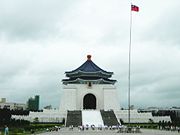
After the defeat of Japan during World War II, Taiwan was surrendered to the Allies, with ROC troops accepting the surrender of the Japanese garrison. Taiwan was pronounced "retroceded" to the Chinese Republic, the effective successors of the Chinese Qing Dynasty on October 25, 1945, although proponents of Taiwan independence dispute the validity of the proclamation, arguing that the proclamation was made without a peace treaty formally transferring sovereignty. The military administration of the ROC extended over Taiwan, which led to widespread unrest and increasing tensions between Taiwanese and mainlanders. The arrest of a cigarette vendor and the shooting of a bystander on February 28, 1947 triggered island-wide unrest, which was then suppressed with military force in what is now called the 228 Incident. Mainstream estimates of casualties range from 10,000 to 30,000, mainly Taiwanese elites. The administration declared martial law in 1948.
The Chinese civil war between the Communists and the Nationalists resumed and intensified. By the 1950s, the Republic of China lost effective control over mainland China and Hainan. Chiang Kai-shek evacuated the government from Nanjing and made Taipei the provisional capital of China. Accompanying his retreat were some two million refugees from mainland China, adding to the earlier population of approximately six million.
Initially, the United States abandoned the KMT and expected that Taiwan would fall to the Communists. However, in 1950 the conflict between North Korea and South Korea, which had been ongoing since the Japanese withdrawal in 1945, escalated into full-blown war, and in the context of the Cold War, U.S. President Harry S. Truman intervened again and dispatched the 7th Fleet into the Taiwan Straits to prevent hostilities between Taiwan and mainland China. In the Treaty of San Francisco, which came into force on April 28, 1952, and the Treaty of Taipei, which came into force on August 5, 1952, Japan formally renounced all right, claim and title to Formosa (Taiwan) and the Pescadores (Peng-hu), and renounced all treaties signed with China before 1942. Both treaties remained silent about who would take control of the island, in part to avoid taking sides in the Chinese Civil War. Advocates of Taiwan independence have used this omission to call into question the PRC and ROC claims on Taiwan, arguing that the future of Taiwan should be decided by self-determination. Continuing conflict of the Chinese Civil War through the 1950s, and intervention by the United States notably resulted in legislations such as the Sino-American Mutual Defense Treaty and the Formosa Resolution of 1955.
During the 1960s and 1970s, the ROC began to develop into a prosperous, technology-oriented industrialized developed country, while maintaining an authoritarian, single-party government. Because of the Cold War, most Western nations and the United Nations regarded the ROC as the sole legitimate government of China until the 1970s and especially after the termination of the Sino-American Mutual Defense Treaty; after that, most nations switched diplomatic recognition to the PRC.
Government
Republican China
The first national government of the Chinese Republic was established on January 1, 1912, in Nanjing, with Sun Yat-sen as the provisional president. Provincial delegates were sent to confirm the authority of the national government, and they later also formed the first parliament. The power of this national government was both limited and short-lived, with generals controlling both central and northern provinces of China. The limited acts passed by this government included the formal abdication of the Qing dynasty and some economic initiatives.
Shortly after the rise of Yuan Shikai, the parliament's authority became nominal; violations of the Constitution by Yuan were met with half-hearted motions of censure, and Kuomintang members of the parliament that gave up their membership in the KMT were offered £1,000 British pounds. Yuan maintained power locally by sending military generals to be provincial governors or by obtaining the allegiance of those already in power. Foreign powers came to recognize Yuan's power as well: when Japan came to China with 21 demands, it was Yuan who submitted to them, on May 25, 1915.
When Yuan died, the parliament of 1913 was reconvened to give legitimacy to a new government. However, the real power of the time passed to military leaders, forming the warlord period. The impotent government still had its use; when World War I began, several Western powers and Japan wanted China to declare war on Germany, in order to liquidate German holdings.
Present
The head of state is the President, who is elected by popular vote for a four-year term on the same ticket as the Vice-President. The President has authority over the five administrative branches (Yuan): the Control Yuan, Examination Yuan, Executive Yuan, Judicial Yuan and Legislative Yuan. The President appoints the members of the Executive Yuan as his cabinet, including a Premier, who is officially the President of the Executive Yuan; members are responsible for policy and administration.
The main legislative body is the unicameral Legislative Yuan with one hundred and thirteen seats. Seventy-three are elected by popular vote from single-member constituencies; thirty-four are elected based on the proportion of nationwide votes received by participating political parties in a separate party list ballot; and six are elected from two three-member aboriginal constituencies. Members serve three-year terms. Originally the unicameral National Assembly, as a standing constitutional convention and electoral college, held some parliamentary functions, but the National Assembly was abolished in 2005 with the power of constitutional amendments handed over to the Legislative Yuan and all eligible voters of the Republic via referendums.
The Judicial Yuan is ROC's highest judiciary. It interprets the constitution and other laws and decrees, judges administrative suits, and disciplines public functionaries. The President and Vice-President of the Judicial Yuan and fifteen Justices form the Council of Grand Justices. They are nominated and appointed by the President of the Republic, with the consent of the Legislative Yuan. The highest court, the Supreme Court, consists of a number of civil and criminal divisions, each of which is formed by a presiding Judge and four Associate Judges, all appointed for life. In 1993, a separate constitutional court was established to resolve constitutional disputes, regulate the activities of political parties and accelerate the democratization process. There is no trial by jury but the right to a fair public trial is protected by law and respected in practice; many cases are presided over by multiple judges.
The ROC's political system does not fit traditional models. The Premier is selected by the President without the need for approval from the Legislature, but the Legislature can pass laws without regard for the President, as neither he nor the Premier wields veto power. Thus, there is little incentive for the President and the Legislature to negotiate on legislation if they are of opposing parties. In fact, since the election of the pan-Green's Chen Shui-bian as President in 2000 and the continued control of the Legislative Yuan by the pan-Blue majority, legislation has repeatedly stalled, as the two sides have been deadlocked. There is another curiosity of the ROC system; because the ROC was previously dominated by strongman single party politics, real power in the system shifted from one position to another, depending on what position was currently occupied by the leader of the state. This legacy has resulted in executive powers currently being concentrated in the office of the President rather than the Premier.
The term ruling party was previously applied to the Kuomintang, as it was the authoritarian party that controlled all aspects of government (ruling party may also be applied to the majority party in a parliamentary system). The Soviets, who had trained Chiang and the KMT and the Communists, left a lasting mark on the practices of the KMT, and under a Leninist -style single-party state, there was little difference between the ROC government, the KMT, and the army. Today, however, the term "ruling party" has a specific, peculiar use in Taiwan and is used to describe the party holding the Presidency. This is not entirely accurate since Taiwan does not have a parliamentary system, where the executive branch is occupied by the same party or coalition that holds a majority in the legislature. This term is currently used because the Premier is appointed by the President, thus executive powers tend to be dominated by the party holding the Presidency.
Administrative regions
According to the 1947 Constitution, written before the ROC government retreated to Taiwan, the highest level administrative division is the province, which includes special administrative regions, regions, and centrally-administered municipalities. However, in 1998 the only provincial government to remain fully functional under ROC jurisdiction, Taiwan Province, was streamlined, with most responsibility assumed by the central government and the county-level governments (the other existing provincial government, Fuchien, was streamlined much earlier). The ROC currently administers two provinces and two provincial level cities.
Counties
|
|
|
||||
|---|---|---|---|---|---|
| Taiwan Province | Fujian Province | ||||
| Counties | Municipalities | Counties | |||
|
|
|
|
|
|
| Municipalities | Claimed political divisions | ||||
|
|
||||
The Republic of China also controls the Pratas Islands (Dong-Sha) and Taiping Island, which are part of the disputed South China Sea Islands. They were placed under Kaohsiung City after the retreat to Taiwan.
Taichung is currently under consideration for elevation to central municipality status. Also, Taipei County and Kaohsiung County are considering mergers with their respective cities.
The ROC has not constitutionally renounced sovereignty over Mainland China and Outer Mongolia, but President Lee Teng-hui announced in 1991 that his government does not dispute the fact that the Communist Party rules Mainland China. In practice, although ROC law still formally recognizes residents of mainland China as citizens of the ROC, it makes a distinction between persons who have household residency in the Free Area of the Republic of China and those that do not, meaning that persons outside the area administered by the ROC must apply for special travel documents and cannot vote in ROC elections. The DPP government under Chen Shui-bian has established a representative office in Mongolia's capital, Ulan Bator. Offices established to create the appearance of domestic governance of those regions, such as the Mongolian and Tibetan Affairs Commission, lie dormant.
Municipalities and cities
ROC official boundaries continue to show thirty-five provinces, fourteen municipalities, one special administrative region and two regions, instead of the twenty-three provinces, four municipalities, two special administrative regions and five autonomous regions shown on PRC maps. The former DPP government of Chen Shui-bian had dropped regulations which had required ROC map makers to depict the constitutional boundaries.
Politics
1911–49
The original founding of the Republic centered on the Three Principles of the People (san min zhuyi): Nationalism, Democracy, and People's Livelihood (also translated "Socialism"). "Nationalism" meant standing up to Japanese and European interference, "democracy" represented elected rule modeled after the Diet of Japan, and the "people's livelihood" meant government regulation of the means of production. Another subordinate principle was the "republic of Five Races" (五族共和), which emphasized the harmony of the five major ethnic groups in China ( Han, Manchus, Mongols, Tibetans, and Uyghurs), represented by the colored stripes of the original Five-Colored Flag of the Republic. The Five Races Under One Union principle and the five-colored flag were abandoned in 1927.
The Three Principles were not realized. Republican China was riven by warlordism, foreign invasion, and civil war. There were elected legislators, but Republican China was largely a one-party dictatorship, with some minor parties, such as the Chinese Youth Party, the National Socialist Party, and the Rural Reconstruction Party. Within the KMT, there was suppression of dissent by the Communists. The central government was weak and unable to implement land reform or wealth redistribution. Politics of this era consisted primarily of political and military struggle between the KMT and the CPC between periods of military resistance against Japanese invasion.
1949–2005
The constitution of the Republic of China was drafted before the fall of Mainland China to the Communists. It was created for the purpose of forming a coalition government between the Nationalists and the Communists for ruling all of China, including Taiwan. However, the CPC boycotted the National Assembly, and the Taiwanese representatives were not elected. The constitution went into effect December 25, 1947.
Taiwan remained under martial law from 1948 until 1987 and much of the constitution was not in effect. Political reforms beginning in the late 1970s and continuing through the early 1990s liberalized the ROC from an authoritarian one-party state into a multiparty democracy. Since the lifting of martial law, the Republic of China has democratized and reformed, removing legacy components that were originally meant for the governing of mainland China. Many legacy components that remain are nonfunctional. This process of amendment continues. In 2000, the KMT's monopoly on power ended after the Democratic Progressive Party (DPP) won the ROC presidency. In May 2005, a new National Assembly was elected to reduce the number of parliamentary seats and implement several constitutional reforms. These reforms have been passed; the National Assembly has essentially voted to abolish itself and transfer the power of constitutional reform to the popular ballot.
Present
Major camps
The political scene in the ROC is divided into two camps, with the pro-unification and centre-right KMT, People First Party (PFP), and New Party forming the Pan-Blue Coalition, and the pro-independence and centre-left Democratic Progressive Party (DPP) and centrist Taiwan Solidarity Union (TSU) forming the Pan-Green Coalition.
Separate identity resolution
On September 30, 2007, the ruling Democratic Progressive Party approved a resolution asserting separate identity from China and called for the enactment of a new constitution for a "normal country". It called also for general use of "Taiwan" as the island's name, without abolishing its formal name, the Republic of China.
The Pan-Green camp tends to favour emphasizing the Republic of China as being a distinct country from the People's Republic of China. Many Pan-Green supporters seek formally declaring Taiwan independence and to drop the title of the Republic of China. Many members of the coalition, such as current President Chen Shui-bian, have moderated their views and explain that it is unnecessary to proclaim independence because "Taiwan is already an independent, sovereign country" and the Republic of China is the same as Taiwan. A small minority claim that the ROC is nonexistent and call for the establishment of an independent Republic of Taiwan. Supporters of this idea have issued self-made "passports" for their Republic of Taiwan. Attempts to use these "passports" however have been currently stopped by officials at the Taiwan Taoyuan International Airport.
Some Pan-Blue members, especially former leaders from the older generation, support the concept of the Republic of China, which remains an important symbol of their links with China. During his visit to mainland China in April 2005, former KMT Party Chairman Lien Chan reiterated his party's belief in the "One China" policy, which states that there is only one China controlled by two governments and that Taiwan is a part of China. PFP Party Chair James Soong expressed the same sentiments during his visit in May. The more mainstream Pan-Blue position is to lift investment restrictions and pursue negotiations with the PRC to immediately open direct transportation links. Regarding independence, the mainstream Pan-Blue position is to maintain the status quo, while being open to negotiations for unification.
Current political issues
The dominant political issue in the ROC is its relationship with the PRC. Some people in the ROC desire the opening of direct transportation links with the People's Republic of China (PRC), including direct flights. This would aid many ROC businesses that have opened factories or branches in the PRC. The current DPP administration fears that such links will lead to tighter economic and political integration with the PRC, and in the 2006 Lunar New Year Speech, President Chen Shui-bian called for managed opening of links.
Other major political issues include the passage of an arms procurement bill that the United States authorized in 2001, and the establishment of a National Communications Commission to take over from the Government Information Office, whose advertising budget exercised great control over ROC media.
The politicians and their parties have themselves become major political issues. Corruption among some DPP administration officials has been exposed. The KMT was once the richest political party in the world and KMT assets continue to be an issue. In early 2006, President Chen Shui-bian was linked to possible corruption. The political effect on President Chen Shui-bian was great, causing a divide in the DPP leadership and supporters alike. It eventually led to the creation of a Pan-Red camp led by Ex-DPP leader Shih Ming-teh which believe the President should resign than stay in disgrace; forming a 3 side standoff. Nearing the end of 2006, KMT's chairman Ma Ying-jeou was also hit by a corruption scandal, although he has since then been cleared of any wrong-doings by the courts.
The merger of the KMT and PFP was thought to be certain, but a string of defections from the PFP to the KMT have increased tensions within the Pan-Blue camp. There has been talk from both camps of amending the constitution to finally resolve whether the Republic of China should have a presidential system or a parliamentary system.
Foreign relations
1911–49
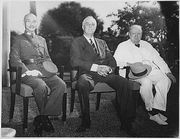
The foreign policy of Republican China was complicated by a lack of internal unity; competing centers of power all claimed legitimacy. There was also foreign interference and invasion. Japan, the United Kingdom, France, Italy, Germany, Russia, and other major powers all made claims to various parts of China during this time. During the early years of the Republic, almost all foreign powers recognized the "warlord" government controlled by Yuan Shi-kai in Beijing as the legitimate government of China. In return for recognition, the Republic had to give up control of Outer Mongolia and Tibet. China would remain suzerain, but Russia would be allowed to influence Mongolia while the British would be allowed in Tibet. It was also this government that sent representatives to sign the Treaty of Versailles over protests by students in the May Fourth Movement.
After the defeat of the Beiyang Government in Beijing by the Kuomintang (Nationalists) and the purging of Communists from the party, the 1928 Nanjing Nationalist Government received widespread diplomatic recognition. This recognition lasted throughout the Chinese Civil War and World War II (though Japan established a rival puppet government during the invasion that received some recognition from the Axis Powers). Having fought on the side of the Allied Powers during World War II, the Republic of China became one of the founding members of the UN and held one of the five permanent seats on the UN Security Council.
Despite Chiang's failures as an administrator and military strategist, he is today recognized for several diplomatic successes. In the 1930s, he was able to moderate Japanese advances by negotiating aid from Nazi Germany. Immediately prior to World War II, he was able to secure aid from his former patrons, the Soviets. During World War II and immediately afterwards, he was able to obtain large amounts of support from the US, including lend-lease supplies. Huge infusions of military assistance, equipment, advice, and cash continued even after he evacuated the KMT to Taiwan.
1949–present
After the KMT retreat to Taiwan, most countries, notably the countries in the Western Bloc, continued to maintain relations with the ROC. Due to diplomatic pressure, recognition gradually eroded and many countries switched recognition to the PRC in the 1970s. There are now only 23 countries that maintain official diplomatic relations with the ROC.
The PRC refuses to have diplomatic relations with any nation that recognizes the ROC, and requires all nations with which it has diplomatic relations to make a statement recognizing its claims to Taiwan. In practice most major nations maintain unofficial relations with the ROC and the statement required by the PRC is ambiguously worded. The ROC maintains unofficial relations via Taipei Economic and Cultural Representative Offices or "Taipei Representative Offices" that take on most of the functions of an official embassy, such as issuing visas. Similarly, most nations maintain corresponding trade and economic offices in the ROC, such as the American Institute in Taiwan, which is the de facto embassy of the United States in the ROC.
The ROC was a founding member of the United Nations and held China's seat on the Security Council until 1971, when it was expelled by General Assembly Resolution 2758 and replaced in all UN organs with the PRC. Multiple attempts by the ROC to rejoin the UN have not made it past committee. (See China and the United Nations.)
Besides the dispute with the PRC over the mainland, the ROC also has a controversial relationship with Mongolia. Until 1945, the ROC claimed jurisdiction over Greater Mongolia, but under Soviet pressure, it recognized Mongolian independence. Shortly thereafter, it repudiated this recognition and continued to claim jurisdiction over Mongolia until recently. Since the late 1990s, the relationship with Mongolia has become a controversial topic. Any move to renounce sovereignty over Mongolia is controversial because the PRC claims that it is a prelude to Taiwan independence.
The ROC is required to use the name Chinese Taipei to participate in international events due to People's Republic of China's interpretation of the One-China policy which many international organizations choose to follow. Among organizations that have this requirement are international sports federations, including the International Olympic Committee.
Military
1911–49
Several armies were associated with this era, including those of the various warlords, the KMT, and the CPC. There were two armies regarded as the "National army": the Beiyang Army of the Warlord government and later the National Revolutionary Army of the Nationalist Government.
The founding of the Republic was made possible by mutiny within the Qing New Army. When Yuan Shikai took over as president, he was already commander of the Beiyang Army, which controlled North China. However, with Yuan's death in 1916, numerous factions within the Beiyang Army broke loose, and the leading generals of the Beiyang Army became warlords, ruling huge fiefdoms in the following decade. Regulars in these warlord armies often did not wear uniforms and the distinction between bandit and soldier was blurred.
With the help of the Comintern, Sun Yat-sen established the National Revolutionary Army in 1925 in Guangdong with a goal of reunifying China under the Kuomintang. To this end, it initially fought against the warlords who had fractured China, successfully unifying China, and later against the Communist Red Army. A minor Sino-Soviet conflict in 1929 was fought over the administration of the Manchurian Chinese Eastern Railway. The National Revolutionary Army also fought against Japanese invasion during the Second Sino-Japanese War (1931 and 1937–45), which became a part of the larger World War II. Leadership of the military during this time empowered political leadership. Following the principles of Leninism the distinctions among party, state, and army were blurred.
When the People's Liberation Army won the Chinese Civil War, much of the National Revolutionary Army retreated to Taiwan along with the government. It was later reformed into the Republic of China Army. Units which surrendered and remained in China were either disbanded or incorporated into the PLA.
Present
Today, the Republic of China maintains a large and technologically advanced military, mainly as defense against the constant threat of invasion by the PRC under the Anti-Secession Law of the People's Republic of China. From 1949 to the 1970s the military's primary mission was to "retake the mainland." As this mission has shifted to defense, the ROC military has begun to shift emphasis from the traditionally dominant army to the air force and navy. Control of the armed forces has also passed into the hands of the civilian government. As the ROC military shares historical roots with the KMT, the older generation of high ranking officers tends to have Pan-Blue sympathies. However, many have retired and there are many more non-Mainlanders enlisting in the armed forces in the younger generations, so the political leanings of the military have moved closer to the public norm in Taiwan.
The ROC's armed forces number approximately 300,000, with nominal reserves totaling 3,870,000. The ROC began a force reduction program to scale down its military from a level of 430,000 in the 1990s which drew to a close in 2005. Conscription remains universal for qualified males reaching age eighteen, but as a part of the reduction effort many are given the opportunity to fulfill their draft requirement through alternative service and are redirected to government agencies or defense related industries. Current plans call for a transition to a predominantly professional army over the next decade. Conscription periods will decrease by two months each year, with a final result of three months.
The armed forces' primary concern at this time is the possibility of an attack by the PRC, consisting of a naval blockade, airborne assault and/or missile bombardment. Four upgraded Kidd class destroyers were recently purchased from the United States, significantly upgrading Taiwan's air defense and submarine hunting abilities. The Ministry of National Defense planned to purchase diesel-powered submarines and Patriot anti-missile batteries from the United States, but its budget has been stalled repeatedly by the opposition- Pan-Blue Coalition controlled legislature. The defense package has been stalled since 2001 and there is now debate about the relevance of the submarines and whether different hardware should be purchased. A significant amount of military hardware has been bought from the United States, and continues to be legally guaranteed today by the Taiwan Relations Act. In the past, the ROC has also purchased military weapons and hardware from France and the Netherlands.
The first line of defense against invasion by the PRC is the ROC's own armed forces. Current ROC military doctrine is to hold out against an invasion or blockade until the U.S. military responds. A defense pact between the U.S. and Japan signed in 2005 implies that Japan would be involved in any response. Other U.S. allies, such as Australia, could theoretically be involved but this is unlikely in practice. It is also worth noting that there is no guarantee in the Taiwan Relations Act or any other treaty that the United States will attack the PRC, even in the event of invasion.
Economy
1912–49

During the first half of the twentieth century the economy of the Republic of China was essentially capitalist, with much foreign interference. Progress was impeded by constant war and internal and external strife.
The weak national government made some attempts to promote economic activity, such as by establishing the Industrial Bank of China. There was little government control of the economy however, other than causing runaway inflation by overprinting money to finance wars against the Japanese and the Communists. Foreign debts also made the national government susceptible to foreign influence. The Nationalists, like Yuan Shi-kai before them, were propped up through massive economic loans by the United States.
China at the time was largely agrarian, with most of the land, and thus the wealth, concentrated in a wide pyramid structure. Much of the land was owned by a few very wealthy landowners; the general population were tenant farmers who did not own land. The founders of both the Republic of China and the Communist Party had aimed to overturn this inequality. The Henan famine (1943–44) aided the collapse of the Republican government. Labor unions had been crushed in the purge of the Communists from the Kuomintang, leading to more inequality. Many of the wealthiest landowners and business leaders were also ministers and officials of the state and were often corrupt, preventing effective measures from being implemented.
Taiwan Miracle
Taiwan's quick industrialization and rapid growth during the latter half of the twentieth century, has been called the " Taiwan Miracle" (台灣奇蹟) or "Taiwan Economic Miracle". As it has developed alongside Singapore, South Korea and Hong Kong, the ROC is one of the industrialized developed countries known as the " Four Asian Tigers".
Japanese rule prior to and during World War II brought forth changes in the public and private sectors of the economy, most notably in the area of public works, which enabled rapid communications and facilitated transport throughout much of the island. The Japanese also improved public education and made the system compulsory for all ROC citizens during this time.
When the KMT government fled to Taiwan it brought the entire gold reserve and the foreign currency reserve of mainland China to the island which stabilized prices and reduced hyperinflation. More importantly, as part of its retreat to Taiwan, KMT brought with them the intellectual and business elites from the mainland. This unprecedented influx of monetary and human capital laid the foundation for Taiwan's later dramatic economic development. The KMT government instituted many laws and land reforms that it had never effectively enacted on mainland China. The government also implemented a policy of import-substitution, attempting to produce imported goods domestically. Much of this was made possible through US economic aid, subsidizing the higher cost of domestic production. Native Taiwanese were largely excluded from the mainlander-dominated government.
In 1962, Taiwan had a per capita gross national product (GNP) of $170, placing the island's economy squarely between Zaire and Congo. By 2005 Taiwan's per capita GNP, adjusted for purchasing power parity (PPP), had soared to $29,000 (2006 est.), contributing to a Human Development Index equivalent to that of other developed countries.
According to economist Paul Krugman, the rapid growth was made possible by increases in capital and labor, but not an increase in efficiency. In other words, the savings rate increased, and work hours were both lengthened and many more people, such as women, entered the work force.
Dwight Perkins and others cite certain methodological flaws in Krugman's (and Alwyn Young's) research, and suggest that much of Taiwan's growth can be attributed to increases in productivity. These productivity boosts were achieved through land reform, structural change (urbanization and industrialization), and an economic policy of export promotion rather than import substitution.
Present
Today the Republic of China has a dynamic capitalist, export-driven economy with gradually decreasing state involvement in investment and foreign trade. In keeping with this trend, some large government-owned banks and industrial firms are being privatized. Real growth in GDP has averaged about eight percent during the past three decades. Exports have provided the primary impetus for industrialization. The trade surplus is substantial, and foreign reserves are the world's third largest. The Republic of China's current GDP (PPP) per capita is equal to the average of EU Countries.
The Republic of China has its own currency, the New Taiwan dollar.
Agriculture constitutes only two percent of the GDP, down from 35 percent in 1952. Traditional labor-intensive industries are steadily being moved offshore and with more capital and technology-intensive industries replacing them. The ROC has become a major foreign investor in the PRC, Thailand, Indonesia, the Philippines, Malaysia, and Vietnam. It is estimated that some 50,000 Taiwanese businesses and 1,000,000 businesspeople and their dependents are established in the PRC.
Because of its conservative financial approach and its entrepreneurial strengths, the ROC suffered little compared with many of its neighbors from the 1997 Asian Financial Crisis. Unlike its neighbors South Korea and Japan, the Taiwanese economy is dominated by small and medium sized businesses, rather than the large business groups. The global economic downturn, however, combined with poor policy coordination by the new administration and increasing bad debts in the banking system, pushed Taiwan into recession in 2001, the first whole year of negative growth since 1947. Due to the relocation of many manufacturing and labor intensive industries to the PRC, unemployment also reached a level not seen since the 1970s oil crisis. This became a major issue in the 2004 presidential election. Growth averaged more than 4% in the 2002-2006 period and the unemployment rate fell below 4%.
The ROC often joins international organizations under a politically neutral name. The ROC is a member of governmental trade organizations such as the World Trade Organization under the name Separate Customs Territory of Taiwan, Penghu, Kinmen and Matsu since 2002.
Education
The Republic of China has a twenty-two year comprehensive educational system influenced by the Japanese educational system. The system has been successful in that pupils in the ROC boast some of the highest test scores in the world, especially in mathematics and science; however, it has also been criticized for placing excessive pressure on students and eschewing creativity in favour of rote memorization.
The literacy rate is 96.1%.
Demographics
The population of areas under control of the Republic of China was estimated in July 2006 at 23,036,087 spread across a total land area of 35,980 square kilometres (13,890 sq mi) making it the twelfth most densely populated country in the world with a population density of 640/km² (1,658/sq mi). 98% of Taiwan's population is made up of Han Chinese while 2% are Austronesian aborigines.
| Taiwan religiosity | ||||
|---|---|---|---|---|
| religion | percent | |||
| Buddhism | 35.1% | |||
| Taoism | 33% | |||
| Irreligion | 14% | |||
| Christianity | 3.9% | |||
| Ikuantao | 3.5% | |||
There are approximately over 18,718,600 religious followers in Taiwan as of 2005 (81.3% of total population) and over 14-18% are non-religious. According to the newest census as of 2005 of the ROC government recognizes 26 religions, the five largest religious organizations in Taiwan are: Buddhism (8,086,000 or 35.1%), Taoism (7,600,000 or 33%), I-Kuan Tao (810,000 or 3.5%), Protestantism (605,000 or 2.6%), Catholicism (298,000 or 1.3%) and smaller religions. But according to the CIA World Factbook and other latest sources from U.S. Department of States or the Religious Affairs Section of the MOI, over 80% to 93% of the population were influenced by the mixture of Buddhism, Taoism, Confucianism and Ancestor worship.
Taiwan is undergoing a decline in birth rates with a population growth of just 0.61% for the year 2006. The official national language is Mandarin Chinese though the majority also speak Taiwanese (deriving from the Min Nan speech of Fujian province) and Hakka. Aboriginal languages are becoming extinct as the aborigines have become sinicized and the ROC government has not preserved the Formosan languages.
Largest cities
The figures below are the 2007 estimates for the ten largest urban populations within administrative city limits; a different ranking exists when considering the total municipal populations (which includes suburban and rural populations).
| Rank | Core City | Division | Pop. | |||||||
|---|---|---|---|---|---|---|---|---|---|---|
| 1 | Taipei | Taipei City | 2,629,269 | 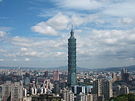 Taipei |
 Kaohsiung |
|||||
| 2 | Kaohsiung | Kaohsiung City | 1,520,555 | |||||||
| 3 | Taichung | Taichung City | 1,055,898 | |||||||
| 4 | Tainan | Tainan City | 764,658 | |||||||
| 5 | Banciao | Taipei County | 543,342 | |||||||
| 6 | Jhonghe | Taipei County | 409,698 |
 Taichung |
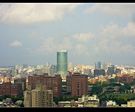 Tainan |
|||||
| 7 | Hsinchu | Hsinchu | 400,430 | |||||||
| 8 | Keelung | Keelung | 390,397 | |||||||
| 9 | Sinjhuang | Taipei County | 389,541 | |||||||
| 10 | Sanchong | Taipei County | 388,979 | |||||||
| 2007 Census | ||||||||||
Public health
Health care in the ROC is managed by the Bureau of National Health Insurance (BNHI).
The current program was implemented in 1995 and is considered a social insurance. The government health insurance program maintains compulsory insurance for employed, impoverished, un-employed citizens and persons of natural disasters with fees that correlate to the individual and/or family income; it also maintains protection for non-citizens working in Taiwan. The 2001 premium for the district population was US$18.88 per person per month. A standardized method of calculation applies to all persons and can optionally be paid by an employer or by individual contributions.
BNHI insurance coverage requires co-payment at the time of service for most services unless it is a preventative health service, for low-income families, veterans, children under three years old, or in the case of catastrophic diseases. Low income households maintain 100% premium coverage by the BNHI and co-pays are reduced for disabled or certain elderly peoples.
According to a recently published survey, out of 3,360 patients surveyed at a randomly chosen hospital, 75.1% of the patients said they are "very satisfied" with the hospital service; 20.5% said they are "okay" with the service. Only 4.4% of the patients said they are either "not satisfied" or "very not satisfied" with the service or care provided.
Taiwan has its own Centre for Disease Control, and during the SARS outbreak occurring in March of 2003 confirmed 347 cases. During the outbreak the CDC and local governments set up monitored stations throughout public transportation, recreational sites and other public areas. With full containment in July of 2003, there has not been a case of SARS reported since.
BNHI Facility Contract Distribution facilities total 17,259, including:
| Number | Subject |
|---|---|
| 16,174 | outpatient-only facilities |
| 5,701 | dental clinics |
| 2,422 | Chinese medicine clinics |
| 1,085 | inpatient/outpatient facilities |
| 437 | local community hospitals |
| 35 | Chinese medicine hospitals |
| 23 | academic medical centers |
Basic coverage areas of the insurance include:
|
|
|
* child check-ups, prenatal care, pap smears, adult check-ups
In 2004 the infant mortality rate was 5.3 with 15 physicians and 63 hospital beds per 10,000 people. The life expectancy for males was 73.5 years and 79.7 years for females according the World Health Report. Since the inception of the BNHI in 1995 the aggregate life expectancy increase is 1.6 years for males and 2 years for females, possibly a key indicator for success in the BNHI program considering the relatively stable life expectancy rate prior to the initiative.
Other health related programs in Taiwan are the Centre for Disease Control and the Department of Health.
Calendar
Following the imperial tradition of using the sovereign's era name and year of reign, official ROC documents use the Republic (Chinese: 民國; pinyin: míngúo; literally "The Country of the People") system of numbering years in which the first year (民國元年) was 1912, the year of the founding of the Republic of China. For example, 2007 is the "96th year of the Republic" (民國九十六年, 民國96年, or simply 96). As Chinese era names are traditionally two characters long, 民國 (Republic) is employed as an abbreviation of 中華民國 (Republic of China).
Months and days are numbered according to the Gregorian calendar. Based on Chinese National Standard CNS 7648: Data Elements and Interchange Formats — Information Interchange — Representation of Dates and Times, (similar to ISO 8601), year numbering may use the A.D. system as well as the ROC era. For example, May 3, 2004 may be written 2004-05-03 or R.O.C.93-05-03.
The ROC era numbering happens to be the same as the numbering used by North Korea because its founder, Kim Il-sung, was born in 1912. The years in Japan's Taishō period (July 30, 1912 to December 25, 1926) are also coincident with the ROC era.
The use of the ROC era system extends beyond official documents. When used to mark expiration dates on products for export, they can be misunderstood as having an expiration date 11 years earlier than intended. Misinterpretation is more likely in the cases when the prefix (R.O.C. or 民國) is omitted.
Traditional Chinese holidays such as the Chinese New Year, the Lantern Festival, and the Dragon Boat Festival are celebrated regularly.
International rankings
| Context | Organization | Rank | Year | Source |
|---|---|---|---|---|
| GDP (PPP) | International Monetary Fund / CIA | 19/179 (IMF) 18/227 (CIA) |
2007 | IMF CIA |
| GDP (PPP) per capita | International Monetary Fund / CIA | 28/179 (IMF) 40/227 (CIA) |
2007 | IMF CIA |
| Worldwide press freedom index | Reporters Without Borders | 32/169 | 2007 | |
| Freedom of the Press | Freedom House | 20/194 | 2007 | |
| Index of Economic Freedom | The Wall Street Journal and the Heritage Foundation | 26/162 | 2007 | |
| Economic Freedom of the World | Fraser Institute | 24/130 | 2004 | |
| Ease of Doing Business Index | World Bank | 50/178 | 2008 | |
| Global Competitiveness Report | World Economic Forum | 13/125 | 2006–2007 | |
| Business Competitiveness Index | World Economic Forum | 21/121 | 2006 | |
| Worldwide quality-of-life index | The Economist | 21/111 | 2005 | |
| Global e-Government Study | Brown University | 2/198 | 2006 | |
| Richard Lynn and Tatu Vanhanen IQ and Global Inequality |
Dr. Richard Lynn, Professor Emeritus of Psychology at the University of Ulster |
5/185 | 2006 | |
| World Competitiveness Yearbook | International Institute for Management Development | 13/55 | 2008 | |
| Network Readiness Index | World Economic Forum | 17/127 | 2007–2008 | |
| Corruption Perceptions Index | Transparency International | 34/180 | 2007 | |
| Travel and Tourism Competitiveness Index | World Economic Forum | 30/124 | 2007 | |
| IT industry competitiveness index | Economist Intelligence Unit | 6/64 | 2007 | |
| E-readiness rankings | Economist Intelligence Unit | 19/70 | 2008 | |
| Environmental Performance Index | Yale University | 40/149 | 2008 | |
| Bertelsmann Transformation Index (Status) | Bertelsmann Foundation | 4/125 | 2008 | |
| Bertelsmann Transformation Index (Managem.) | Bertelsmann Foundation | 7/125 | 2008 |


